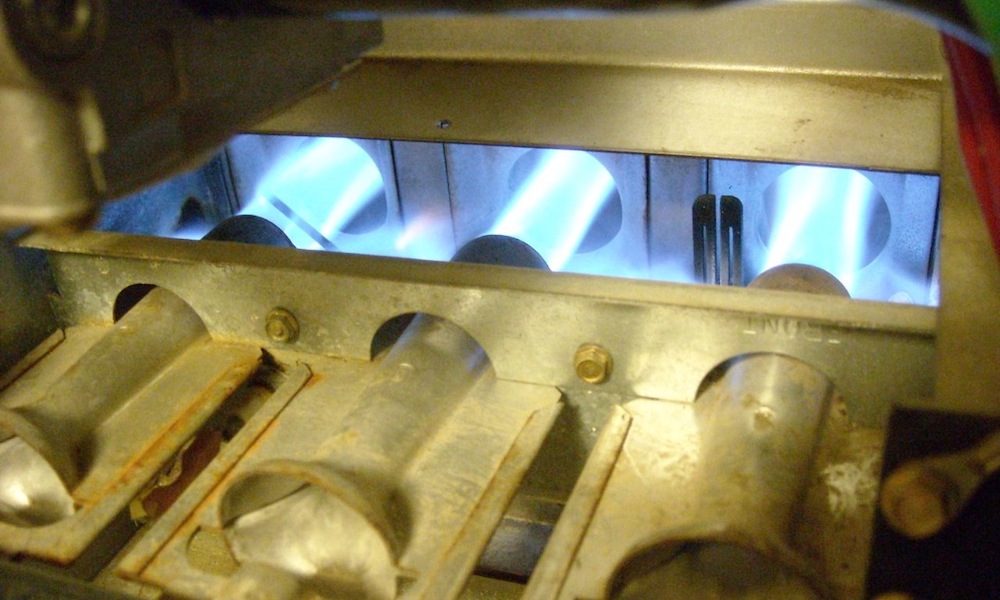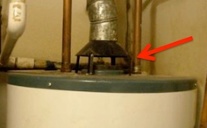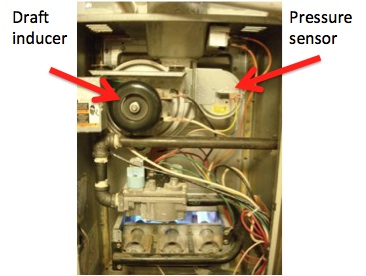3 Problems with Atmospheric Combustion Inside the Building Envelope

A lot of houses have atmospheric combustion appliances. What that means is that a lot of houses have the potential for problems with atmospheric combustion, including serious health and safety problems as well as higher energy bills.
First, let me define atmospheric combustion because, unless they’re in the HVAC business or have training in how to do a home energy audit, many people don’t know what it means. An atmospheric combustion appliance is one that draws air from the space around the appliance. You could, if you desired, pull the cover off and stick your finger into the blue flame. (Strangely, fewer people are drawn to do that than to stick their tongues on a frozen steel pole.)
The two atmospheric combustion appliances of most concern are furnaces and water heaters. (Fireplaces deserve their own article, so I’ll leave them for later.) If your atmospheric combustion furnace or water heater is in a vented crawl space or a vented attic, it’s outside the building envelope and is less likely to create health and safety problems inside the house. (Less likely but not impossible.)
Here’s the basic process for furnaces and water heaters:
- Pull in air to mix with the natural gas.
- Burn the mixture of gas and air.
- Exhaust the combustion gases to the outside through the flue.
I’ve left out the part about why we’re burning gas in the first place, which is to add heat to the home or the water in the water heater’s tank. Here, my only concern is the combustion process.
in the water heater’s tank. Here, my only concern is the combustion process.
An atmospheric combustion furnace pulls room air into the combustion chamber through the grill on the front (photo right). A water heater pulls air in at the bottom near the pilot light.
Problem #1 – Negative pressure increases infiltration.
When the furnace or water heater or both are running, they’re pulling in room air and sending it to the outside. A basic rule of building science, and something that all home energy auditors learn, is that for every cubic foot of air that leaves the house, another cubic foot of air comes in. By running these atmospheric combustion appliances inside the conditioned space, you’re increasing the infiltration that the house experiences. Your energy bills will be higher as a result, and you may find the house a bit drafty while the furnace is running.
I’ve written in this space before that you can’t make a house too tight, but you have to pay attention to the combustion safety issues before you go air-sealing your home. You want it tight, but you don’t want to increase the probability for the next problem.
Problem #2 – Negative pressure can backdraft the water heater.
 See that gap between the top of the water heater and the bottom of the flue? It’s designed to draw air in to aid the natural draft (stack effect) of the water heater. Warm air rises, so as a water heater runs and the warm combustion gases rise in the flue, the opening helps allowing more warm air from the room to rise.
See that gap between the top of the water heater and the bottom of the flue? It’s designed to draw air in to aid the natural draft (stack effect) of the water heater. Warm air rises, so as a water heater runs and the warm combustion gases rise in the flue, the opening helps allowing more warm air from the room to rise.
The problem here is that that opening also allows air to come down the flue. If the air pressure in the room is low enough relative to the air pressure where the flue terminates outside, air will come down the flue. If air is coming down the flue while the water heater is firing, combustion gases will not go up the flue. They’re coming into the room.
This is where things get interesting. Under normal operating conditions, with the combustion gases exhausting up the flue, the combustion process results mainly in water vapor and carbon dioxide. When the water heater is backdrafting, the combustion process changes. The flame may get starved for oxygen, causing incomplete combustion, which results in significantly more carbon monoxide in the combustion gases.
Carbon monoxide, needless to say, is bad. You don’t want it in the air in your house, which is exactly where it goes if the water heater is backdrafting. It can’t go up the flue.
Problem #3 – Common venting of water heaters and furnaces overrides an important safety feature of furnaces.
At the base of the flue in an atmospheric combustion furnace is a draft inducer. It’s a little fan that pulls air up through the heat exchanger. Right next to that fan is a pressure sensor that will cut off the furnace if it detects that the pressure in the flue is too high. If a squirrel or a bird builds a nest at the top of the flue, and the combustion gases can’t escape, this sensor can save your life by shutting off the furnace.

When your water heater flue is connected to the furnace flue (see second photo above), however, that squirrel nest at the top of the flue still keeps the combustion gases from going out, but the sensor may not detect a high enough pressure to shut off the furnace. The reason is that the combustion gases now have another escape path – at the top of the water heater!
The Solutions
If you have atmospheric combustion inside the building envelope in your home, here are some options to eliminate or reduce the likelihood of problems:
- Go with a sealed combustion furnace and direct vent, power-vented, or sealed combustion water heater if you still want to use gas inside the conditioned space.
- Create a sealed combustion closet out of the room where the atmospheric combustion appliances are. To do this, you need to isolate the room completely by air-sealing between it and the rest of the house and then bringing in combustion air.
- Convert from natural gas to electricity. We recently ran a two guest posts from David Butler advocating for this approach: Just Say No to Furnaces in High Performance Homes and Heat Pumps and Hydronics – A Great Team for High Performance Homes.
Combustion safety is a huge issue, and it’s a big part of looking at the house as a system, which takes us back to Building Science 101. It’s certainly possible to use natural gas safely in our homes, but we need to pay attention and do it the right way. The problems with atmospheric combustion listed above are not the right way.
Allison Bailes of Atlanta, Georgia, is a speaker, writer, building science consultant, and the founder of Energy Vanguard. He has a PhD in physics and writes the Energy Vanguard Blog. He is also writing a book on building science. You can follow him on Twitter at @EnergyVanguard.
Related Articles
Combustion Safety 101: Three Types of Problems
The Problem of Getting Air for Atmospheric Combustion Appliances
Don’t Compromise — Get a Low-Level Carbon Monoxide Monitor
NOTE: Comments are closed.
This Post Has 14 Comments
Comments are closed.

this issue is far too often
this issue is far too often neglected and can readily have fatal consequences. it must be addressed as we tighten homes! thanks to you, scott suddreth & others, hopefully, the message will become mainstream … when we understand the “systems engineering approach to building science”, we understand how the parts should interact with the whole.
combustion safety must be a priority as we retrofit!
Excellent way of pointing out
Excellent way of pointing out the bypassing of the pressure switch in a common vented application Allison!
Keep up the good work.
Great article Allison and
Great article Allison and definitely a good example in #3!
I am excited to read the article regarding fireplaces issues. I have recently run into a couple houses where the gas fireplaces are back-drafting into the home and have even heard of a regular wood burning doing the same thing. This is on a consistent basis and not just when it is windy outside! All of the homes have been retrofitted with foam within the past 5 years.
Thanks again for the good blog entries!!
Thanks, Paul & Les!
Thanks, Paul & Les! Glad you like the article.
Thanks, David. I learned about the problem of common venting from you when you did the combustion safety testing at my condo in ’09. (In case you didn’t recognize it, the photos above are from my house.)
Where I live, water heaters
Where I live, water heaters are typically installed in the garage. In hot climates, this is actually more efficient than inside the envelope. Anyone who has studied EF ratings knows that the water heaters with the highest EF’s are atmospheric (non-condensing).
In mixed climates, garage is probably a wash in terms of efficiency (especially if garage is insulated), with all the savings on the front end.
In cold climates, sealed combustion begins to look attractive.
One caveat: whether you put an atmospheric water heater in a garage, attic, basement, crawl, or combustion closet, do NOT install furnace or air handler nearby. That tight return side plenum may not always be so tight. In any case, the HVAC belongs inside the envelope in all climate zones.
BTW: your top picture violates the proximity principle. And I’m ashamed to say, ditto in my previous home.
David, you make some good
David, you make some good points, as always. Although combustion safety is the main concern of this post, when you’re looking at alternatives, it’s important to consider other factors, such as efficiency.
I totally agree that the furnace and water heater are too close to each other here (my condo, no less). Even worse, I didn’t show you the dryer that’s in the same room with them. This arrangement is unfortunately all too common, especially in older housing like my 40 year old condo. The only thing that saves us is the 30+ ACH50 infiltration rate. It’s kinda hard to backdraft a water heater with that much air leakage. That’s why I haven’t done the air sealing yet that I’d love to do.
Related to this, has anyone
Related to this, has anyone done a thorough study of the use of all the primitive ‘traps’ added to thwart the undesired inflow of cold air in the combustible air ducts when the furnace/ water heaters are off? I would expect the stack effect is going to pull cold air in, anyway, without a more sophisticated fan-linked system, but am particularly curious as to how the traps are supposed to work, and if they’re really based on sound principles? P-traps work in water vents because water is held in the low portion, but that affects incoming air; I can’t see how a layer of cold air can effectively keep air from flowing freely.
Information pointed me in
Information pointed me in right direction. Water heater in attic, and noticed corrosion. Discovered vent had been displaced, so reattached. The roof was replaced a couple years ago and with it grates (term?) that replaced the older round roof ventilation (which seems less effective). There is a large caged open area above the porch that is suppose to facilitate air flow. Now that I’ve reattached the water heater vent, I also put a regular house fan up there (not pointed at the heater) but a bit behind and adjacent, blowing toward the porch (from attic). So far I’ve not read anything whether it’s a good idea or counter productive. Advice? Thanks, Rj
“Your energy bills will
“Your energy bills will be higher as a result.” Not true! Some infiltration, with humidity change, & draftiness, that’s all. According to Dr. LG Austin, Penn State: “from a heat balance point of view, it’s immaterial where the cold air enters, through a window crack, or through a venting pipe…” citation: http://www.popsci.com/archive-viewer?id=xAEAAAAAMBAJ&pg;=119&query;=outside%20combustion%20air%20%20flue%20%20balance It’s all chemical engineering, not physics!
Tom D: Not
Tom D: Not so fast. The only way what Dr. Austin says can be true is if the furnace is more efficient when burning warm air than cold air. Further, it would have to save exactly as much energy as is lost by the additional runtime of the furnace due to the higher heating load from infiltration. But how could that be true for every type of furnace, with blowers that have different efficiencies and duct systems that are all over the map? And looking at the combustion process, the amount of oxygen in denser cold air would have more of an impact than the kinetic energy of those oxygen molecules.
I’m not sure what Dr. Austin was thinking there. I guess he thought physics was different in 1976 than it is today.
I believe this is a cause of
I believe this is a cause of the epidemic increase in autism spectrum disorder and dementia we are experiencing in this country. The increase coincides with the movement to seal up our homes.
Gloria: A
Gloria: A fundamental principle of science is that correlation does not prove causality. Otherwise, one could just as well say that the dwindling numbers of pirates on the open sea is responsible for the rise in global temperatures.
Allison, I know that. I have
Allison, I know that. I have two graduate degrees. I studied this subject due to having been exposed to chronic low levels of carbon monoxide for several years. This needs further study. Retrospective studies that include subdivisions that were built with tight insulation and gas atmospheric water heaters and furnaces exhaused to the same chimney would tell the story. Also, gas stoves with no outside vent that blow the exhaust back into your face while cooking could be included. Good luck to you and your family.
@Savanna, if the water heater
@Savanna, if the water heater is “atmospheric” (e.g., not sealed combustion) and is installed inside the building envelope, it *must* have exterior venting, typically installed in a nearby wall. You can tell it’s an atmospheric water heater if the flue is metal and there’s a big gap between the top of the water heater and the flue collar.
You can find the details in the installation manual (available online), but in general, a high and low vent are required if closet has a solid door. The vents are sized according to the BTU capacity of the burner. If closet has louvered door and adjoining space is over a certain size, or the water heater is located in a large room, a smaller single vent is acceptable.